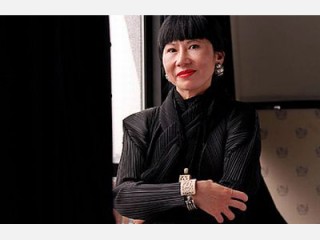
Amy Tan biography
Date of birth : 1952-02-19
Date of death : -
Birthplace : Oakland, California
Nationality : American
Category : Famous Figures
Last modified : 2010-11-27
Credited as : Writer, first novel: The Joy Luck Club,
Amy Tan is known for her lyrically written tales of emotional conflict between Chinese-American mothers and daughters separated by generational and cultural differences. Together with her distinctive writing style and rich imagery, Tan's treatment of such themes as loss and reconciliation, hope and failure, friendship and familial conflict, and the healing power of storytelling have brought her popular success and critical attention.
Tan was born in Oakland, California. Her father was a Chinese-born Baptist minister; her mother was the daughter of an upper-class family in Shanghai. While still in her teens, Tan experienced the loss of both her father and her sixteen-year-old brother to brain tumors and learned that two sisters from her mother's first marriage in China were still alive (one of several autobiographical elements she would later incorporate into her fiction). Tan majored in English at San Jose State in the early 1970s rather than fulfill her mother's expectations of becoming a neurosurgeon, and after graduate work at the University of California, Berkeley, she began a career as a technical writer. After meeting her new-found sisters in China in 1987, Tan was, she has said, "finally able to say, 'I'm both Chinese and American.' … Suddenly some piece fit in the right place and something became whole." As a release from the demands of her technical writing career, she turned to fiction writing, having gained inspiration from her reading of Louise Erdrich's novel of Native American family life, Love Medicine. Tan's first novel, The Joy Luck Club, received the Commonwealth Club gold award for fiction and the American Library Association's best book for young adults award in 1989 and stayed on the New York Times's bestseller list for nine months. In 1993, with Tan serving as a producer and coauthor of the screenplay, The Joy Luck Club was made into a critically acclaimed film. Tan's second novel, The Kitchen God's Wife, was published in 1991 followed by the children's books The Moon Lady (1992) and The Chinese Siamese Cat (1994).
The Joy Luck Club comprises sixteen stories told by four Chinese immigrant women and their four American-born daughters, linked together by the narrative of Jing-mei Woo, whose mother had founded a women's social club in China to sustain its members' spirits during the communist revolution. In the novel, the club becomes a metaphor for the reconciliation of the conflict between maternal expectation and tradition, and filial individuality and cultural independence. In The Kitchen God's Wife, Tan again focused on the mother-daughter relationship in the context of the transition from the suffering and traditions of the Chinese past to the freedom and anxiety of the Chinese-American present. In particular, Tan explored themes of secrecy and misunderstanding, physical abuse and illness, and female friendship and acceptance in the story of the reconciliation of a mother and daughter alienated from each other by the personal truths they conceal from each other. Written for children, The Moon Lady developed a story first told in The Joy Luck Club: a young girl's experience of danger, magic, and wish fulfillment at a celebration of the Moon Festival in traditional China.
Some reviewers of The Joy Luck Club argued that Tan's thematic development was unsuccessful and resulted in strained, "over-significant" scenes, while others found her use of multiple narrative voices to be "limiting" and "over-schematic." However, critical reception of the novel was generally favorable. Carolyn See, for example, described Tan as a "magician of language" while Michael Dorris called Tan a "writer of dazzling talent." Tan solidified her critical reputation with The Kitchen God's Wife. Reviewers found it superior in structure and execution to The Joy Luck Club and applauded Tan's decision to narrow the scope of the narrative to a single mother-daughter relationship. Critics generally commended Tan's storytelling ability and characters development. Josephine Humphreys wrote that The Kitchen God's Wife proved "something profound … about the usefulness of storytelling as a way of … evaluating human experience."
Bestsellers 89, issue 3, Gale, 1989, pp. 69-71.
Contemporary Literary Criticism, Gale, Volume 59, 1990.
















